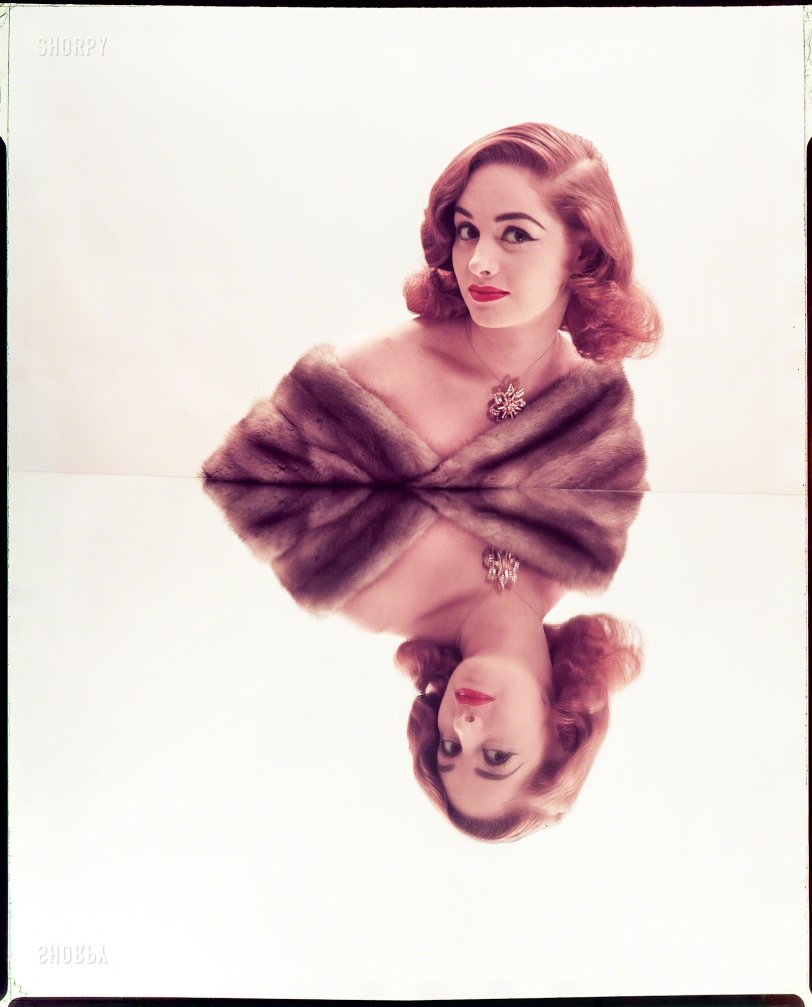


Framed or unframed, desk size to sofa size, printed by us in Arizona and Alabama since 2007. Explore now.
Shorpy is funded by you. Patreon contributors get an ad-free experience.
Learn more.

- Freeze Frame
- Texas Flyer wanted
- Just a Year Too Soon
- WWII -- Replacing men with women at the railroad crossing.
- Yes, Icing
- You kids drive me nuts!
- NOT An Easy Job
- I wonder
- Just add window boxes
- Icing Platform?
- Indiana Harbor Belt abides
- Freezing haze
- Corrections (for those who care)
- C&NW at Nelson
- Fallen Flags
- A dangerous job made worse
- Water Stop
- Passenger trains have right of way over freights?
- Coal
- Never ceases to amaze me.
- Still chuggin' (in model form)
- Great shot
- Westerly Breeze
- For the men, a trapeze
- Tickled
- Sense of loneliness ...
- 2 cents
- Charm City
- What an Outrage
- Brighton Park
Print Emporium
Doppelginger: 1952

July 1952. "Photographs show models posed leaning shoulders against mirrors, resulting in reflected images. Includes women wearing furs and jewels; various hairstyles." Color transparency by Louis Faurer for the Look magazine assignment "Reflected Beauty: Hair Now Gets Double Exposure." View full size.
Shorpy Image
I like the mirror image "Shorpy."
Re: Focus
Thank you for the explanation, Dave. The idea of two reflections is something I could never have imagined. So is the double-the-distance rule for a mirror mistaken?
[Focus is determined by the distance that light travels between the camera and the subject; in the case of a reflection, that distance is the the sum of camera>mirror + mirror>subject. The sum would be double the camera>mirror distance only when that was identical to the mirror>subject distance, for example, when taking a photo of yourself in a mirror. -tterrace]
Top to Bottom
My first thought when I viewed this image was it could easily be accomplished today by using Photoshop. But then I realized that the two views have some subtle differences.
The view in the mirror is showing the underside of her chin and her lower curls. The hair at the top of her head is not visible in the reflected view. It also has a not too flattering view looking up her nose.
The luminance value of the background in the mirror is brighter than the non reflected background. I suspect this might be caused by the different angle of view of the background in the mirror.
Fantastic mirrored SHORPY watermark too.
Focus
My dad taught me that to focus properly on an image in a mirror, you first had to focus on the image, then double the distance. The out-of-focus lower image (the one in the mirror) would appear to bear out this lesson, as the photographer had to choose one of them to be in focus and he obviously chose the upper.
[It looks out of focus because it's two reflections -- a faint one from the top of the mirror, superimposed on the strong one from the bottom (silvered) surface. -Dave]
























On Shorpy:
Today’s Top 5